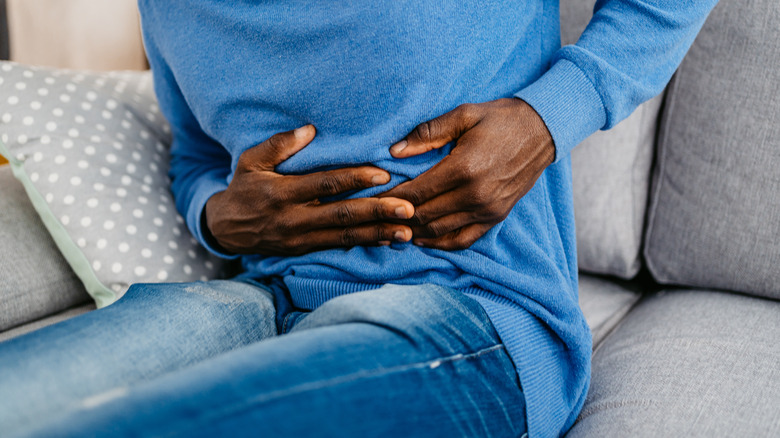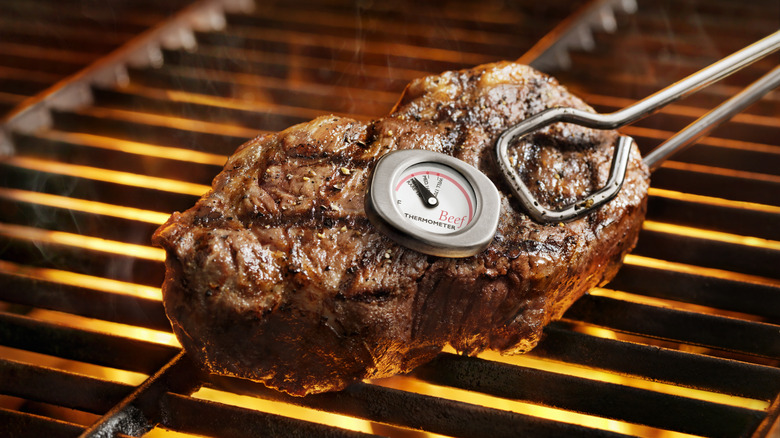Here's What You Need To Do If You Eat Raw Meat By Mistake
When it comes to cooking meat from a food safety perspective, achieving the right level of "doneness" is crucial. But even with the best intentions, mistakes can and do happen, among them the accidental ingestion of raw or undercooked meat. In this case, remain calm and take immediate steps to mitigate possible health risks. First and foremost, wash your hands thoroughly after consuming raw meat to avoid potentially spreading pathogens to others.
As for your personal health, keep in mind that it can take some time for food poisoning symptoms to appear. According to Johns Hopkins Medicine, symptoms like nausea, vomiting, and diarrhea can take as long as three weeks to present, but most people fall ill within one to three days. (If that happens, it's strongly recommended that you contact a medical professional to discuss your symptoms.)
You'll also need to provide information on the type of raw meat you've eaten, as different types of meat can harbor different pathogens, bacteria, and other contaminants. In the event symptoms are mild, however, there are helpful steps you can take at home to alleviate any ill effects you experience.
How to decrease the severity of foodborne illness
As explained by the Mayo Clinic, you can usually treat mild cases of food poisoning on your own using home remedies. Because symptoms like vomiting increase your risk of dehydration, you must drink plenty of fluids. Beverages containing electrolytes, such as sports drinks, are best for warding off dehydration, as they help the body maintain the proper fluid balance, while also supporting essential functions.
Over-the-counter medications are also beneficial when dealing with minor foodborne illnesses caused by raw meat. This includes antidiarrheals and medications designed to reduce nausea. Medical News Today explains that activated charcoal may also be beneficial when dealing with the effects of foodborne illness, but it comes with caveats — there's limited evidence that it can relieve diarrhea to prevent dehydration when battling food poisoning. It's also best to consult with your primary care physician before taking over-the-counter medications to make certain they're right for you.
While home remedies are effective, preventing foodborne illness is equally crucial, if not more so. That's why all home chefs must have a trusty meat thermometer and know how to use it.
What are safe temperatures when cooking meat?
According to FoodSafety.gov, meat must reach a minimum temperature to ensure safe consumption. Raw and undercooked pork carries a significant risk of serious foodborne illness due to trichinosis, a parasitic infection that can have major effects. Fortunately, this and other risks can be mitigated by ensuring a minimum temperature of 145 degrees Fahrenheit when cooking pork chops. As for ground beef, the minimum safe temperature is 160 degrees, while poultry must reach 165 degrees before serving.
The only accurate way to determine the temperature of meat is to use a meat thermometer. You must also use the thermometer correctly to ensure an accurate reading. In this case, stick the thermometer probe into the thickest section of the meat, taking care to avoid any gristle or bone. As for thermometer depth, try to go at least a half-inch into the meat. Increase depth if you're cooking a particularly thick cut of meat to ensure accuracy. Larger servings of meat, such as roasts, will also require resting time. In this case, you can remove the meat from the oven and let it sit for five to 10 minutes, at which point the meat should reach the desired temperature.


